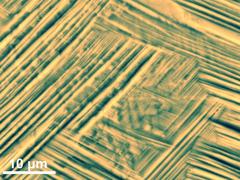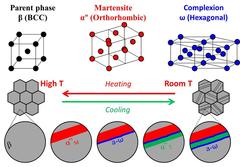URL: https://www.desy.de/news/news_search/index_eng.html
Breadcrumb Navigation
DESY News: Analysis reveals new crystal structure in “gum metal”
News
News from the DESY research centre
Analysis reveals new crystal structure in “gum metal”
Scientists from the Max-Planck-Institut für Eisenforschung (MPIE) in Düsseldorf have observed a new phase transformation in a titanium alloy at DESY. The mechanism they discovered could further our understanding of some surprising properties of certain alloys and be used to develop new materials. The team around main author Jian Zhang of MPIE presents its findings in the journal Nature Communications.

Scanning electron microscopy image showing the different phases in the peculiar gum-type titanium alloy. Credit: Jian Zhang, MPIE
This makes the alloy extremely attractive for various industrial applications. In the aerospace industry, for example, it can be used as a kind of crash absorber. “When an aircraft’s turbine is damaged by hail or a bird strike, there is a risk that individual parts may shatter and damage the fuselage too. If parts of the protective casing around a turbine were made of this type of ‘gum metal’, they could capture the flying debris because the impact would not destroy but only deform them,” says Raabe.
It is not yet quite clear why this alloy can be deformed to such a high degree. Various experiments have revealed peculiarities in its nanostructure, but have not yet shown a direct connection with its properties. Titanium alloys normally occur in two different phases, whereby the term phase refers to the crystal structure in which the atoms are arranged. At room temperature, the atoms are usually found in the so-called alpha phase, at high temperatures they switch to the beta phase. The metals display different properties, depending on which phase they occur in. Gum metals primarily consist of the beta phase, which is stable at room temperature in the case of these alloys.

Schematic model of the titanium alloy showing the crystal structure of the different phases involved during heat treatment. Credit: Jian Zhang, MPIE
If the beta phase is cooled down rapidly from a high temperature, some of the atoms change position to adopt the energetically more favourable arrangement of the alpha phase. The movements of these atoms lead to mechanical stress along the phase boundary, almost as if the different phases were tugging on each other. When this stress exceeds a critical value, a new arrangement is adopted, the so-called omega phase.
“This newly discovered structure only arises when sheer stress is generated at the phase boundary, and it facilitates the transformation of the alpha into the beta phase. It can only exist between two other phases because it is stabilised by them,” reports Raabe. When the stress drops below the critical value because of the new layer, a new alpha phase layer is formed bordering on an omega phase. This results in a microstructure consisting of lots of layers, some of them on an atomic scale, each having a different structure. This transition also occurs when static forces are applied and is completely reversible. The scientists are now hoping that the newly discovered structure will help them to better understand the properties of this material and later to develop new, improved varieties of titanium alloys.
Xi'an Jiaotong University in China and the Massachusetts Institute of Technology in the USA were also involved in the research.
Reference:
Complexion-mediated martensitic phase transformation in Titanium; J. Zhang, C.C. Tasan, M.J. Lai, A-C. Dippel, D. Raabe; Nature Communications, 2017; DOI: 10.1038/ncomms14210



